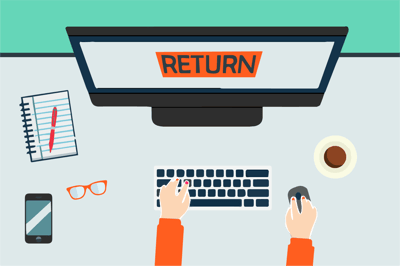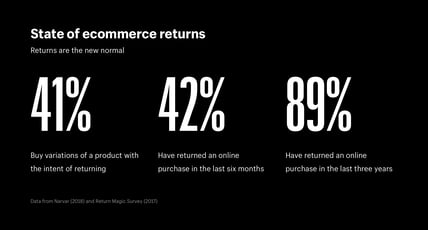The management of eCommerce returns is a challenge brands and retailers can no longer afford to ignore in 2021. It's one of the biggest drawbacks of eCommerce while online orders are at an all-time high! To leverage this online growth, it is important to have your returns under control. Reducing returns has an immediate positive impact on your profit margin.
How should brands and retailers manage and prevent product returns in eCommerce? The key is to optimize the buying journey, both in terms of choosing the right return policy and improving findability, competitiveness, and presentation on the digital shelf.
In this blog you can read about:
Return volumes are increasing

As online sales volumes increase, so do return volumes.
According to CBS, in the 4th quarter of 2020, we saw a turnover development of + 44.5% at Dutch web stores compared to a year earlier.
Dutch consumers return fairly easily and are the leader in Europe. According to research by DPD, on average 13% of the products purchased online are returned. It’s easy to see why the overall number of returns jumped significantly!
For retailers operating in the UK and EU, the immediate impacts of Brexit, including unexpected custom charges, admin fees, and VAT bills, have plunged the retail supply chain into reverse logistics chaos, with 30% of all orders being returned, according to Statista.
What do we do with products that are returned?
There are roughly the following options for a returned product:
- Back in stock for sale at a new price
- Back in stock for sale at a reduced rate (the so-called return deal, or the second chance product)
- To an outlet channel (such as a marketplace) or auction
- Repair / clean / edit first before going to one of these sales channels
- To a buyer for sale outside the Netherlands / Europe
- To a processor for recycling
- To destroy the product
- Apply the 'Keeping returns' Policy (read more about this in the next paragraph)
What option you eventually choose may depend on:
- The type of product
- The condition of the product
- The value of a product
The 'Keeping returns' Policy
Do you give away free products? Most brands and retailers will answer no. But in practice, things seem to work differently. When shoppers decide to return a product, apparently web stores give answers such as: “Return is not required”, “We don't think that's worth the effort”, “Don't sell it to third parties”, or "Please dispose of it in an environmentally friendly way".
According to a survey by the FD (a Dutch Financial Newspaper), shoppers on webshops such as Amazon, and Dutch retailers bol.com and Coolblue, sometimes do not have to send back product returns, even if they are undamaged. Dissatisfied customers automatically get their money back, without having to send things back.
The online retailers do not want to reveal the numbers, but shoppers tell the FD that, according to their experiences, ‘returnless refunds’ regularly occur, while bol.com writes that their policy is to take back and process all returns". Coolblue says that 'very sometimes' returns are left to customers.
Using artificial intelligence, retailers and brands can determine if the cost of shipping the return or the likelihood that the item could not be resold outweighs the benefit of having an item returned. Amazon offers 'keeping returns' as a fixed option for external sellers. Since 2017, external sellers on Amazon who do not want returns can opt for ‘returnless’ refunds. Dissatisfied customers automatically get their money back, without having to send products back.
It is a popular option on Amazon for cheap products with low margins, but in Germany, several sellers on Amazon.de have stopped because of the many cases of abuse. It has been more widely embraced during the pandemic by other major players to help manage the significant returns volume.
Even items that are undamaged and could have been resold, do not have to be sent back to the webshops. From phone cases to headphones, adapters, and cooking pans, often under € 25. If the margin on a product is small, it may be cheaper to leave those items with the customer. A spokesperson for Coolblue calls 'fewer vans' as an environmental reason to leave returns, in addition to higher customer satisfaction and lower costs.
Return Policy & Customer Experience
While many retailers and brands may view returns as an aftermath of a transaction, the return touchpoint is central today to the purchasing decision.
As eCommerce continues to grow and returns with it, retailers and brands should consider how they can enhance the overall customer experience through the process. It may sound weird but it is possible to reduce returns by making the process easier for your customers.
Clearly communicate your return policy. Things shoppers want to know are:
- Do I need to pay for return shipping costs?
- Is the product eligible for return? And if not, why not?
For instance, what exactly is a "used" item? Do you allow returns of accessories and underwear? These are the types of topics that must be explicitly elucidated in your policy.
- What is the return window?
According to Return Magic, 80% of shoppers expect free returns. 71% of customers find that a restocking fee or shipping fee can prevent them from making a purchase. 57% believe that the return window should be at least 30 days.
Due to the corona pandemic online shops are adjusting return windows to survive the tough battle with competitors. The service level of most online shops is very high, with often free delivery and free returns.
Is your brand having its a-game on in every aspect of the return policy?
Our recommendation: Find the right balance between offering an optimal customer experience, keeping the process manageable for your company, and paying attention to sustainability. Either way, quite a challenge!
Do not forget that the returns process offers a unique opportunity to gather insights that may be negative, but can help your brand in the long run.
Prevention is better than cure
Reduced returns have the greatest impact!
We cannot avoid returns altogether. The fact is that 41% of customers buy the same items in multiple sizes or variations, with the intent to return some of them.
There could be a variety of reasons to return a product, like a mismatch between expectations and reality, late delivery, damaged product, or even because the customer found a cheaper alternative elsewhere.
22% of online returns are due to the product being substantially different in appearance than was advertised online
Instead of focusing on the question: "What do we do with products that are returned?", couldn't we better ask ourselves 'What can we do to prevent product returns in eCommerce?".
Yes, we should! Read our tips to prevent returns.
According to Chain Store Age, 65% of returns are due to retailer error (no consumer fault) and 22% of online returns are due to the product being different in appearance than was advertised online.

There are certain things we can do to significantly reduce the number of returns.
6 Tips to Prevent Product Returns
Online shopping is of course not possible without returns, but reducing your unnecessary returns is a necessity in these times and immediately yields a lot. Return reduction has the most significant result on your profitability! Let's look at 6 effective tips that brands and e-retailers can apply to better manage and prevent product returns in eCommerce.
Read our 6 tips to prevent product returns
